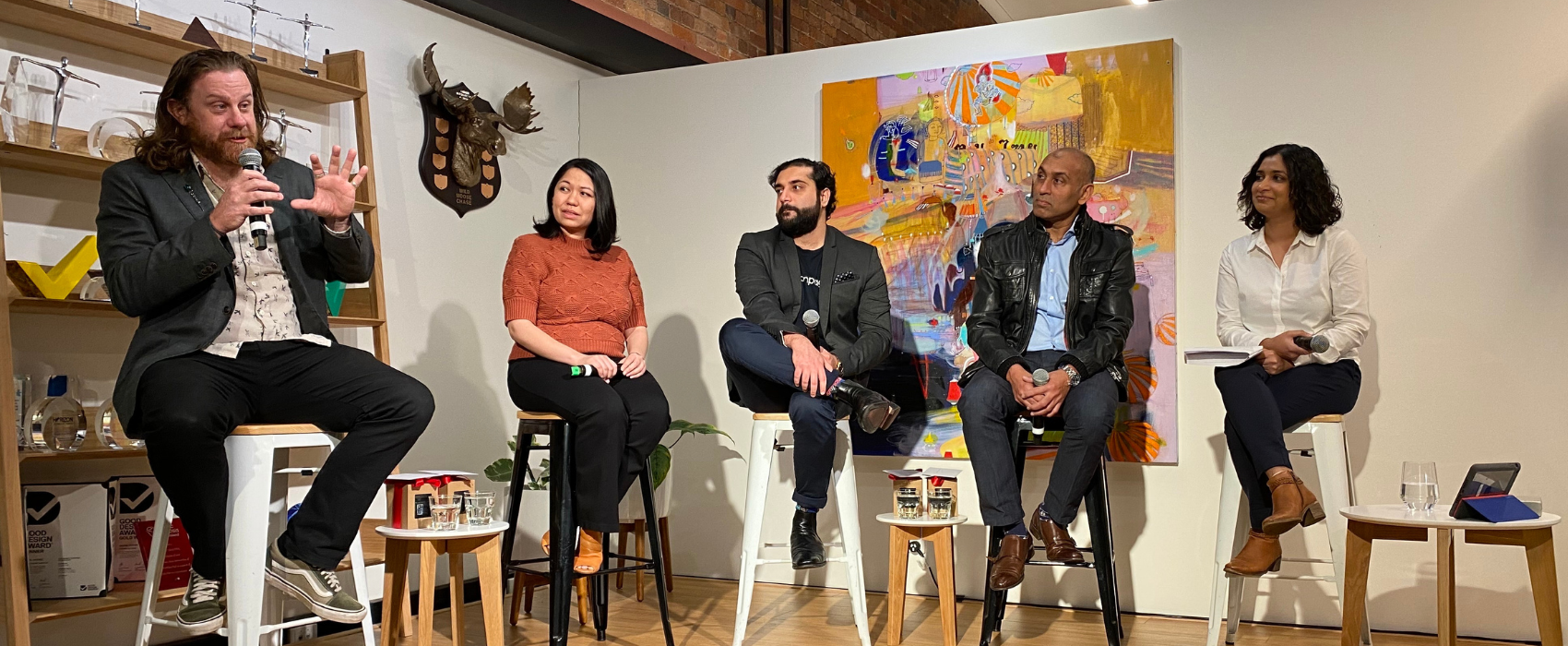Between now and 2050, the number of Australians aged between 65 and 84 is predicted to more than double, and those over 85 to more than quadruple.
As our population ages, how will an already-overstressed health system cope? What are the implications for the care economy? And what role can “Age Tech” play in addressing some of the challenges we are no doubt going to face?
These are some of the questions we tackled at our latest Future Led event about transforming ageing through technology. As expected, there were no straightforward answers, but we had a robust discussion about some of the underlying problems and the immense potential for improvement through behaviour change and genuine co-design.
Our panelists included:
- Simon Lowe, co-founder of The Ageing Revolution
- Roshani Manouchehri, co-founder of Embrayse
- Ali Galadari, CEO and co-founder of Conpago
- Mohan Karunanithi, biomedical engineer and researcher in mobile health applications
(L-R) Simon, Roshani, Ali & Mohan, with Liquid's Judy Das.
Putting people in the ‘over 65’ box
There are a lot of misconceptions about older people's level of competence when it comes to using technology. Older adults also seem to be viewed as one homogenous group, when in fact, people over the age of 65 represent a very diverse group of people with very different wants and needs.
Since the start of COVID, older adults have been using technology more than ever before. Everything from online shopping and banking, to telehealth appointments and catch-ups with family members.
"One of the problems with ageing and ageing systems is the whole idea that all old people are the same; it doesn’t account for the diversity around race or culture or LGBTQ+ or any other variables,” Simon said.
The panel agreed that what's sorely needed is a shift in the way many products and services are designed. Not just in aged care related areas, but everyday systems that everyone uses. Older adults are often left out of the co-design process, and that needs to change.
Co-design means ‘a genuine desire to engage’
Roshani said co-design was an approach founded on a genuine and sincere desire to engage with people.
“When you co-design with someone and you put yourself in their shoes, you think, ‘What do they want to do and how do I build technology that helps them do it with dignity?’ That’s where it starts,” she said.
“And when we start thinking in that way, you suddenly realise there’s a lot of things out there that need to be fixed and replaced, and that’s where the real opportunity for the market comes as well.”
The consensus among the panel was that until and unless older adults are truly involved in the co-design process of products and services, the problems that currently exist will continue.
“Co-design is so important in this sector. It’s absolutely vital,” Ali said.
“One of the things we focus on is actually understanding where the problem is. So when we go into homes or retirement villages, we start to understand what the care recipient wants and often that’s completely different to what the provider is providing.
“A good example is one of our recent clients: on day one, we had 60% adoption out of 300 residents. On day one. Because it was co-designed specifically to their day-to-day needs.”
In one of our earlier blog posts about designing journeys for high-involvement decisions that people don’t want to make, we mentioned the importance of putting your product (or experience) right in front of your customers early in the game, watching how they interact with it, what they enjoy, what they struggle with, and taking on that feedback and those insights.
This was integral as part of our work for My Aged Care. We worked with Australians from rural and urban areas, with diverse needs, backgrounds, and abilities to design new solutions.
The role of technology
In talking about the importance of co-design, the discussion moved to the explosion of Age Tech products in the market and the huge potential for the aged care industry, if designed with and for people.
Mohan said smart homes could provide much more seamless healthcare – allowing humans to focus on the more human aspects of caregiving such as companionship, emotional support, and friendship.
“If you bring healthcare or aged care support or monitoring into the home, you are essentially providing the capacity to support older people in their homes as a business model. And I think the smart-home concept enables the capacity to track a particular older person in a timely manner and intervene,” he said.
“Obviously when it comes to robotics, you’re looking at safety and security in the home. I think eventually it will come with AI, where some of the things around the home will be assistive.”
Simon added that technology had a massive part to play.
“In 30 years, ideally, residential aged care will be extinct ... I think how hospitals work will be changing. I think there will be more in-home care for hospitals,” he said.
“I think there’s potential for home care and apps and technology around how we co-ordinate care, how we co-ordinate the community and redefine what community means.
“How the internet and technology can mean that you can have consultations in your own home with mobile apps, with scanners, with insertions and chips and possibly other things.”
More from our Future Led series:
- Creating a secure and equitable energy future
- 'It matters how co-design practice and purpose is done'
- What role can design play in our fight against cybercrime?
- Here's what we covered in 2021

